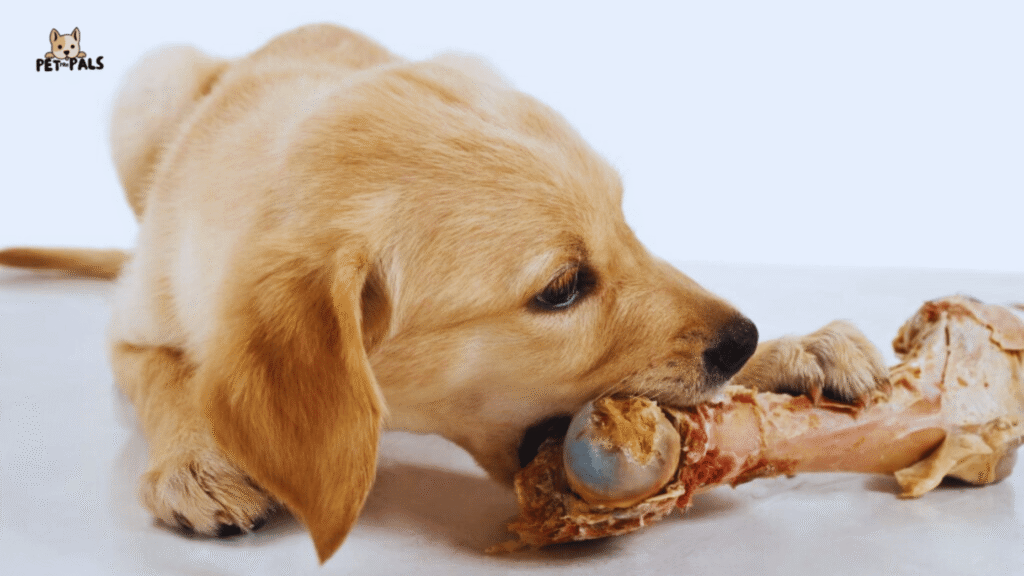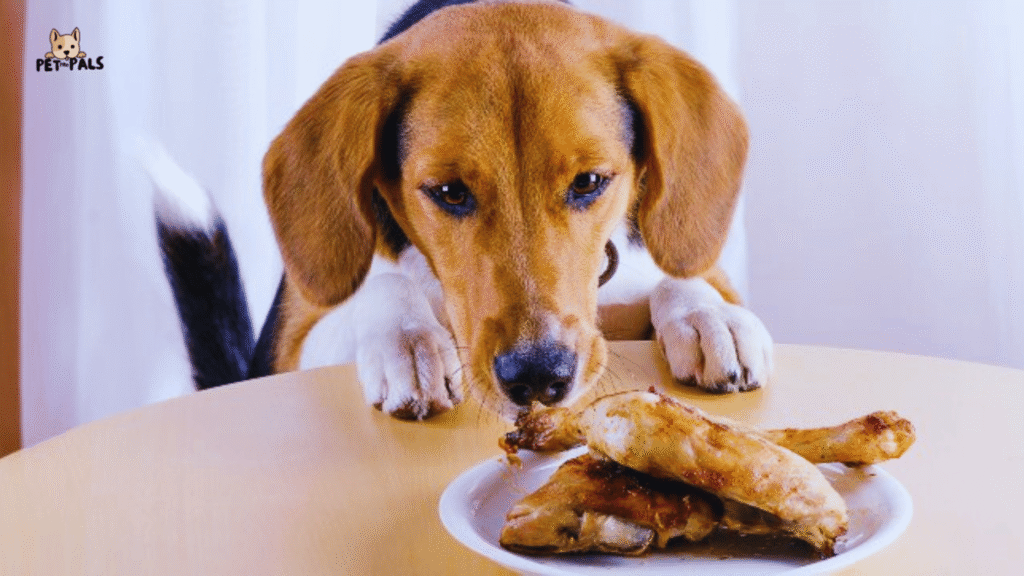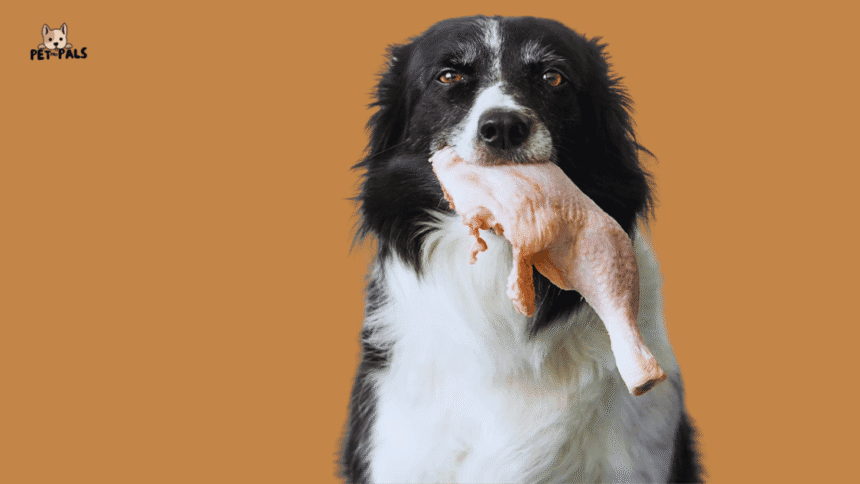It’s a situation every dog owner dreads your pup snatches a raw chicken bone before you can stop them. Your heart skips a beat. You’ve heard chicken bones can splinter and cause serious damage. But then again, some dog owners swear by raw feeding and say it’s natural. So, which is it? Are raw chicken bones safe for dogs, or are you heading for an emergency vet visit?
First off, take a breath. You’re not the first person to face this question, and you won’t be the last. There’s a lot of chatter out there, some of it helpful, some of it just plain scary. That’s why we’re breaking it all down right here, without the fluff or fear-mongering.
We’re going to walk through what the science says, what experienced dog owners and vets have learned, and what you need to know if your dog ate a raw chicken bone. You’ll get straight answers, real context, and practical advice so you can stop guessing and start feeling confident. Let’s get into it.
The Short Answer First: (Yes/No with caveats)

Raw chicken bones can be safe for dogs under the right conditions. According to the American Kennel Club (AKC), raw bones are less likely to splinter than cooked ones, making them safer for chewing and digestion when properly handled. Many raw feeders support this, often including raw chicken wings, necks, and drumsticks in their dogs’ diets without issue.
Unlike cooked bones, which become dry and brittle, raw chicken bones stay soft and flexible. This reduces the risk of choking, internal injury, or digestive damage. However, and this is crucial, not every dog handles raw bones the same way.
There are real risks of raw bones for dogs, especially if they gulp their food, have poor digestion, or underlying health problems. The FDA has also warned about potential bacterial contamination, like Salmonella and Listeria, which can affect not only the dog but also humans through cross-contamination.
So, while feeding raw bones to dogs isn’t automatically dangerous, it’s not a risk-free activity either. If your dog ate a raw chicken bone or you’re thinking of introducing them, there are a few key things to understand to help keep them safe. We’ll cover all of that next.
Raw vs Cooked Chicken Bones – The Key Difference
Raw chicken bones are very different from cooked ones when it comes to how they behave inside a dog’s body.
Raw bones are soft, flexible, and more likely to bend than break. That’s why, for many dogs, they’re easier to chew and digest. In fact, in the world of raw feeding, giving raw bones is a common and accepted practice when done right.
Cooked chicken bones, on the other hand, are a whole different story. Once cooked, bones become dry and brittle. That means they’re way more likely to splinter into sharp fragments, which can lead to serious injuries like choking, internal cuts, or even a punctured intestine. That’s why most vets issue a hard “no” on cooked chicken bones, no matter what.
So when you hear someone say chicken bones are dangerous for dogs, they’re usually talking about the cooked kind. Raw bones are in a completely different category, but they still come with their own set of concerns.
Risks of Feeding Raw Chicken Bones
Even though raw chicken bones don’t splinter like cooked ones, they’re not risk-free. Let’s break down some of the most important concerns:
Choking hazard: Some dogs are gulpers. They don’t chew properly, which increases the risk of choking or swallowing large, undigested chunks. This is especially true for smaller dogs or aggressive eaters.
Gastrointestinal blockage: If a dog swallows a piece of bone that’s too large to pass, it could cause a blockage in the intestines. This might require emergency surgery if it doesn’t pass naturally.
Bacterial concerns: Raw chicken can carry bacteria like Salmonella or Campylobacter. While most healthy dogs can handle a certain level of bacteria, those with weaker immune systems, or homes with small kids or elderly folks, need to be extra careful.
Tooth damage: Believe it or not, bones can crack a dog’s tooth, especially if they’re a strong chewer and the bone is dense or frozen. While less common with chicken bones than beef or pork, it’s still worth mentioning.
So yes, there are risks of raw bones for dogs. But most of these risks are related to how the bone is handled and how the dog eats it, not the bone itself.
Benefits (if done safely)
Now, for the flip side, there are some real benefits to feeding raw chicken bones to dogs when it’s done with care.
- Natural source of nutrients: Raw bones contain calcium, phosphorus, and other minerals that help support bone strength and overall health. For dogs on a raw diet, bones are a key part of nutritional balance.
- Dental health boost: Gnawing on raw bones helps scrape plaque off teeth and massage the gums. It’s a natural way to support dental hygiene, though it’s not a total replacement for regular brushing.
- Mental stimulation: Chewing is calming and engaging for dogs. A raw bone can keep them focused, reduce boredom, and even ease anxiety. It taps into their instinct to chew, which is healthy when channeled properly.
- Digestive health: For some dogs, raw bones help regulate bowel movements by adding firmness to their stool, thanks to the calcium content and bone matter.
When done safely, feeding raw bones to dogs can be a positive, enriching experience. But like anything, it’s not one-size-fits-all. Understanding your dog’s size, chewing style, and overall health is key to making the right call.
Next, we’ll walk through what to do if your dog ate a raw chicken bone, whether by accident or on purpose.
When Raw Bones Might Be Safe: Vet-backed Scenarios
There are times when feeding raw bones to dogs is considered safe, supported by vets who specialize in nutrition or holistic care, as well as raw feeding experts. Here’s when it’s generally okay:
- Healthy adult dogs with no digestive issues: Dogs with strong immune systems and good digestion are better equipped to handle raw meat and bones.
- Supervised feeding only: One of the biggest vet recommendations is to always supervise your dog while they’re chewing. That way, if they start to gulp a piece or struggle, you can intervene right away.
- Appropriate size and type of bone: The bone should match the size and chewing power of your dog. For example, chicken necks or wings may be fine for smaller dogs, while drumsticks or frames may be better for larger breeds.
- Raw-fed dogs used to bones: Dogs who have been on a raw diet for a while and are experienced chewers usually do better with bones than those who’ve only ever eaten kibble.
- Proper food handling practices: If the raw bone has been kept cold and clean (just like you’d treat raw meat for your meal), the risk of harmful bacteria goes down significantly.
Remember, even in these “safer” cases, nothing is guaranteed. But these guidelines reflect scenarios where are raw chicken bones safe for dogs tends to get a “yes” from professionals.
Tips to Feed Raw Chicken Bones Safely
Thinking about giving it a go with your pup? Make sure it’s a positive experience by planning. These simple tips will help you introduce it safely, keep your dog comfortable, and ensure a fun, stress-free time together.
- Start small: If your dog’s never had a raw bone before, don’t jump right into a giant drumstick. Try something small and soft, like a chicken neck, and see how they handle it.
- Serve raw, never cooked: This can’t be stressed enough. Cooked bones are far more dangerous and should be avoided completely.
- Hold the bone at first: Especially with excited or fast eaters, holding the bone while they chew encourages them to slow down. It gives you control and prevents gulping.
- Feed on an empty stomach: Some dog owners swear by feeding raw bones before meals when the dog’s stomach acid is strongest. This can help break down the bone more effectively.
- Keep it fresh: Don’t let a bone sit out too long. If your dog doesn’t finish it, refrigerate or discard it to avoid bacterial growth.
- Avoid weight-bearing bones: Even though we’re talking chicken bones, it’s worth noting—weight-bearing bones from larger animals (like cow femurs) are more likely to break teeth.
Being intentional about how you introduce bones makes all the difference. Safe bones for dogs to chew aren’t just about what kind, they’re about how you serve them.
Signs of Trouble: When to Call the Vet

So what if something goes wrong? Maybe your dog ate a raw chicken bone without you planning it, or maybe something just seems off after they chew. Here are red flags that mean it’s time to get your vet involved:
- Choking or gagging: If your dog is coughing, retching, or seems like something’s stuck, it could be a choking emergency.
- Excessive drooling or pawing at the mouth: This can mean a bone is lodged or causing discomfort in the throat or mouth.
- Lethargy or loss of appetite: If your normally hungry pup suddenly isn’t interested in food, something may be going on internally.
- Vomiting or diarrhea: While a little stomach upset can happen with dietary changes, ongoing vomiting or bloody diarrhea could be signs of a serious issue.
- Straining to poop or signs of pain: This could indicate a blockage or hard stool caused by too much bone matter.
- Bloody stool or black, tarry poop: These can point to internal bleeding, especially if sharp bone fragments have caused damage.
Trust your gut if something seems off; it’s better to be safe and give your vet a call. The earlier you catch a problem, the better the outcome tends to be.
Next up, we’ll talk about what to do if your dog has already gotten into a raw chicken bone because let’s be real, they don’t always wait for your permission.
What the Experts Say
When it comes to feeding raw chicken bones to dogs, expert opinions are somewhat split. However, they do agree on key safety factors. Here’s a closer look at both sides of the debate so you can make an informed choice.
Pro Raw Bones: Veterinarians and raw feeding advocates who support the practice generally highlight that raw bones, like chicken necks or wings, are a natural part of a dog’s diet. They point out that raw bones are softer than cooked ones, making them much less likely to splinter. Many raw feeders also argue that raw bones offer important nutritional benefits, from dental health to bone-strengthening minerals like calcium and phosphorus. They also emphasize that the risks are manageable as long as dogs are supervised and the bones are handled properly.
Cautionary Experts: On the other side, many veterinarians, especially those in conventional practices, urge caution when it comes to feeding raw bones. The primary concern is the risk of choking, gastrointestinal blockages, and the potential for bacterial contamination. Some argue that the risks of raw bones for dogs outweigh the benefits, particularly for dogs who aren’t accustomed to chewing raw food. They recommend safer alternatives, like commercially prepared chews or dental treats, to avoid the unknowns that come with raw bones.
Are raw chicken bones safe for dogs? It depends on your dog’s health, how you manage the situation, and how much risk you’re comfortable taking on. Experts generally agree that supervision is key, but opinions vary widely on whether it’s a good idea for all dogs.
Personal Experience or Pet Owner Case Study
While I don’t have a personal pet story to share, many raw feeding advocates recount experiences that shed light on what it’s like to feed dogs raw chicken bones. Here’s one case study that many dog owners talk about:
Case Study: Max the Golden Retriever
Max, a healthy 3-year-old Golden Retriever, had been on a raw food diet since he was a puppy. His owner, Sarah, had been feeding him raw chicken wings and necks as part of his diet for months. At first, Sarah was nervous, especially when Max eagerly dove into the first few raw bones.
But over time, she became more confident. She always supervised him during chew time, made sure to buy appropriately sized bones, and had him vet-checked regularly. The results? Max’s teeth stayed sparkling clean, his digestion was great, and he loved every meal. Even when Sarah found him gnawing on a leftover chicken drumstick, she wasn’t worried. Max knew how to handle raw bones and had never had a problem.
However, Sarah always made sure to watch for signs of discomfort or trouble. She knew the risks of raw bones for dogs and felt prepared to step in if anything went wrong. So far, she’s never had to worry about Max’s safety with raw bones, but she continues to err on the side of caution.
Max’s case is a great example of how a dog can thrive on raw bones when done safely. But, like any practice, it’s important to be prepared, know your dog’s limits, and take responsibility for how you handle the bones.
Conclusion
Feeding raw chicken bones to dogs isn’t a black-and-white decision. On one hand, they offer some significant benefits, like supporting dental health and providing natural nutrients. On the other hand, there are risks involved, like choking, internal injury, and bacterial contamination, that shouldn’t be overlooked.
If you decide to feed your dog raw chicken bones, take a cautious and informed approach. Start with small, manageable bones that suit your dog’s size and chewing habits. Always supervise your dog during chew time, and pay attention to any signs of distress. If you’re unsure, consult with your vet, especially if your dog has health concerns or a sensitive stomach.
For many dog owners, raw bones can be a safe and rewarding part of their dog’s diet, but only if they approach it responsibly. Your dog’s safety should always come first, and with a bit of care, raw bones can be a healthy treat.
FAQs
Can small dogs eat raw chicken bones?
Yes, but with caution. Small dogs can generally handle raw chicken bones, but it’s crucial to give them appropriately sized bones. Smaller, softer bones like chicken necks or wings are usually a safe choice. Always supervise them while they chew to avoid choking hazards. If you’re unsure, consult your vet to be on the safe side.
How often can dogs eat raw bones?
How often you feed raw bones depends on your dog’s size, health, and diet. For most dogs, offering a raw bone a couple of times a week is enough. If your dog is new to raw bones, start slowly and keep it to a once-a-week treat until you see how they handle it. Too many bones could lead to digestive upset, so moderation is key.
Are frozen raw chicken bones safe?
Frozen raw chicken bones are generally safe for dogs, but there are a few things to consider. Freezing bones can make them harder, which may increase the risk of tooth damage, especially in dogs with weaker teeth. If you’re feeding frozen bones, make sure they’re not too hard and keep a close eye on your dog while they chew. It’s often a good idea to thaw the bones slightly before serving them to avoid these issues.

